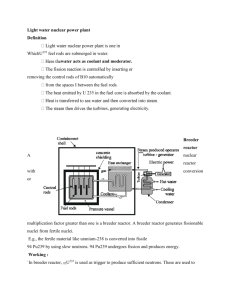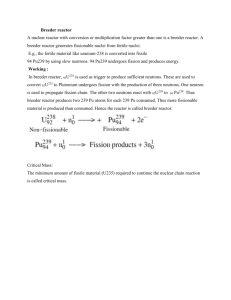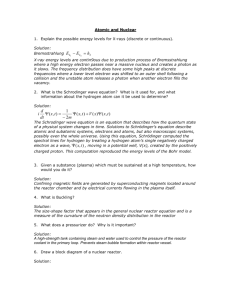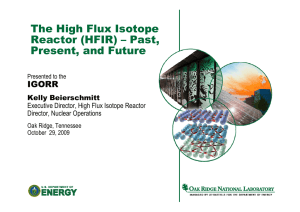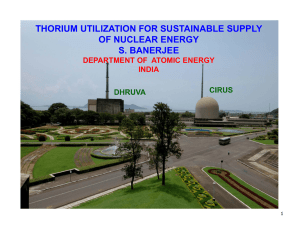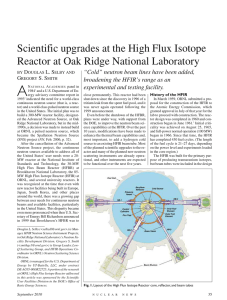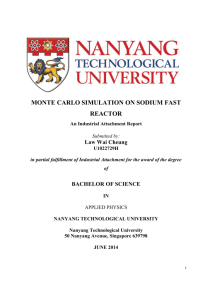For a number of years we have been looking into the possibility
advertisement
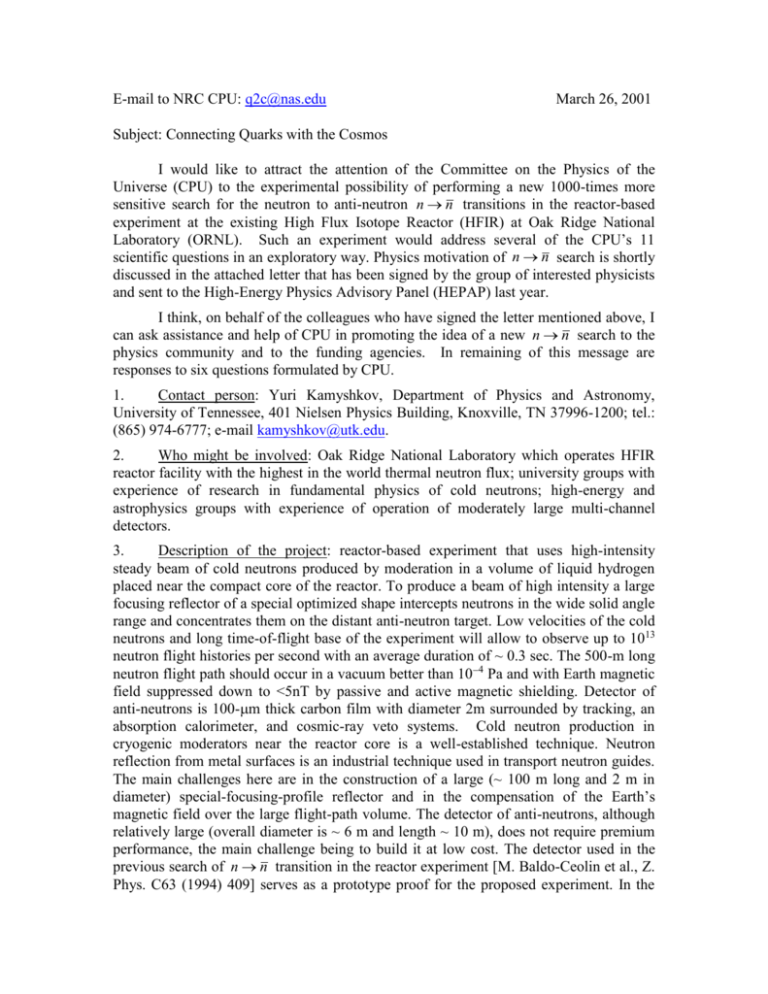
E-mail to NRC CPU: q2c@nas.edu March 26, 2001 Subject: Connecting Quarks with the Cosmos I would like to attract the attention of the Committee on the Physics of the Universe (CPU) to the experimental possibility of performing a new 1000-times more sensitive search for the neutron to anti-neutron n n transitions in the reactor-based experiment at the existing High Flux Isotope Reactor (HFIR) at Oak Ridge National Laboratory (ORNL). Such an experiment would address several of the CPU’s 11 scientific questions in an exploratory way. Physics motivation of n n search is shortly discussed in the attached letter that has been signed by the group of interested physicists and sent to the High-Energy Physics Advisory Panel (HEPAP) last year. I think, on behalf of the colleagues who have signed the letter mentioned above, I can ask assistance and help of CPU in promoting the idea of a new n n search to the physics community and to the funding agencies. In remaining of this message are responses to six questions formulated by CPU. 1. Contact person: Yuri Kamyshkov, Department of Physics and Astronomy, University of Tennessee, 401 Nielsen Physics Building, Knoxville, TN 37996-1200; tel.: (865) 974-6777; e-mail kamyshkov@utk.edu. 2. Who might be involved: Oak Ridge National Laboratory which operates HFIR reactor facility with the highest in the world thermal neutron flux; university groups with experience of research in fundamental physics of cold neutrons; high-energy and astrophysics groups with experience of operation of moderately large multi-channel detectors. 3. Description of the project: reactor-based experiment that uses high-intensity steady beam of cold neutrons produced by moderation in a volume of liquid hydrogen placed near the compact core of the reactor. To produce a beam of high intensity a large focusing reflector of a special optimized shape intercepts neutrons in the wide solid angle range and concentrates them on the distant anti-neutron target. Low velocities of the cold neutrons and long time-of-flight base of the experiment will allow to observe up to 1013 neutron flight histories per second with an average duration of ~ 0.3 sec. The 500-m long neutron flight path should occur in a vacuum better than 104 Pa and with Earth magnetic field suppressed down to <5nT by passive and active magnetic shielding. Detector of anti-neutrons is 100-m thick carbon film with diameter 2m surrounded by tracking, an absorption calorimeter, and cosmic-ray veto systems. Cold neutron production in cryogenic moderators near the reactor core is a well-established technique. Neutron reflection from metal surfaces is an industrial technique used in transport neutron guides. The main challenges here are in the construction of a large (~ 100 m long and 2 m in diameter) special-focusing-profile reflector and in the compensation of the Earth’s magnetic field over the large flight-path volume. The detector of anti-neutrons, although relatively large (overall diameter is ~ 6 m and length ~ 10 m), does not require premium performance, the main challenge being to build it at low cost. The detector used in the previous search of n n transition in the reactor experiment [M. Baldo-Ceolin et al., Z. Phys. C63 (1994) 409] serves as a prototype proof for the proposed experiment. In the new HFIR-based experiment the sensitivity of n n transition search can be increased by factor of 1000 as compared with the previous search performed at the ILL reactor in Grenoble [ibid.]. 4. Cost and schedule: The expected cost of the HFIR-based n n search experiment should be well below $50M (including ~$15M cost of a new cryogenic hydrogen moderator). Provided that funding resources exist, the HB-3 beam at HFIR/ORNL can be available for n n experiment as was demonstrated by us in a seed-money study project supported by ORNL. Expected possible schedule scenario after initiation is: 2 years of Technical Design preparation, 2 years of construction, and 3 years of operation. 5. Science questions addressed: The discovery of n n transition would establish a new phenomenon leading to new physics at the energy scale of ~ 105 GeV. It will provide essential contribution to the understanding of baryon asymmetry in the universe and have major impact on the unification models. New symmetry principles (nonconservation of BL and restoration of L-R symmetry broken in the Standard Model) might be revealed. In modern theories with the Standard Model fields localized on the brane that propagates in higher-dimensional space-time [G. Dvali and G. Gabadadze, hep-ph/9904221], n n transitions might be a preferred mode to the proton-decay type of baryon instability. If n n exists, it will allow further experiments with reactor neutrons and with intranuclear transitions [L.Okun, hep-ph/9612247] to provide the most sensitive test of CPT-theorem and the experimental confirmation of the gravitational equivalence of baryonic matter and antimatter. If n n transition does not exist within the proposed improved sensitivity limits, the new HFIR-based experiment will establish a new limit on the stability of matter (through well-understood connection to the intranuclear n n transitions) at the level of 1035 years, beyond the reach of Super-K and future planned proton-decay experiments. 6. Multi-agency involvement: Although the physics addressed by an n n search belongs to high-energy physics and astrophysics, it does not fall automatically into the scope of HEPAP, which is primarily concerned with the future of accelerator-based physics. That motivated the letter (in attachment to this message) written to HEPAP in support of the development of n n search in US. The HFIR reactor facility at ORNL is operated by Basic Energy Science office of DOE that has a different scientific and operational mission and thus has little expertise in the physics fields related to the proposed n n experiment. ORNL/HFIR management has some difficulty with this divergence of scientific goals and has no good mechanism to support the development of a new n n experiment. For these reasons proposed experiment will be probably a prime candidate for NSF-DOE cooperative effort and due to its relation to the cosmological matters it might be also of interest to NASA. With my best regards, Yuri Kamyshkov Attachment: Letter to HEPAP from September 8, 2000 : //web.utk.edu/~kamyshko/hepap.doc, or hepap.ps, or hepap.pdf


